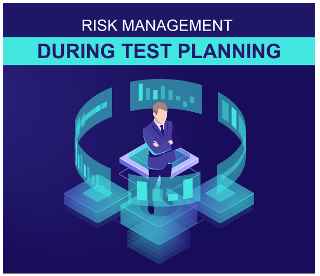Risk Management During Test Planning

Risk management is an important part of the software testing process and is usually done during the test planning phase. In order to understand what the importance of risk management is, you should first know what a risk means.
What is a Risk?
A risk is any event or exception that may pose a threat to the software functionality, security or overall working efficiency. Risks always result in a negative outcome and therefore are a main concern for software developers and testers alike.
Risks are generally a product of a faulty code created with lack of information. Other factors like inconsistency in software features or technical issues can also cause software risks to occur.
What is Risk Management?
In order to detect risks well ahead of time and rectify them, risk management is carried out. Risk management allows you to search the areas of code where the software risk is present and disturbs the system functionality.
Risk management is performed during the test planning process to help testers understand which areas need to be tested for potential risks and create test plans accordingly. Risk management helps testers better understand the system, create efficient test planes and reduce the chances of system failures.
During Test planning, testers make use of various different approaches and methodologies to detect and manage risks. The process of risk management usually consists of identifying, analyzing, prioritizing, controlling and rectifying the risk.
How does risk management affect Test planning process?
During test planning, testers create test cases using their knowledge of the system. These test cases are aimed towards detecting risks and other discrepancies in the system.
With the help of risk management, testers can create more efficient test cases and test plans. Why? During risk management, testers first study and understand the system and analyze which area or code of the system will be the cause of potential risks. They design test plans with this knowledge in mind and therefore the test plans are more robust and effective.
The Risk Management Process during Test Planning
When performing risk management during test planning, the following process is followed:
Risk Identification
Identifying risks during the test planning phase is very important. Why? You can create better test plans when you have knowledge about the risks and the code that can generate it.
So, the first step of test planning is risk identification. You list down the factors which are potential risks for the system. This list may contain internal as well as external risks.
You can identify the risks through various different techniques. Understanding the system objectives, studying the risks that occurred in the previous projects, gaining knowledge about the system, looking at the system structure and architecture, can give you a clear idea of where you can expect risks to occur.
The most common system risks are exceptions, undefined scope, late errors, unavailability of independent testing environment, and excess system demand. Testers search the system for the presence of such risks and inform the developers if any possibility of such risk is found.
Every time test planning is conducted due to change in requirements or system code, risk identification is repeated.
During risk identification, it is advised to document the risks that are identified for future reference.
Related Read: 17 Skills Of Highly Effective Software Testers
Risk Prioritization
The next step in test planning is risk prioritization. Again, this is a very important part of test planning as you will know which risks are of immediate concern and plan your tests accordingly.
You do not want to spend precious time in rectifying trivial errors when more pressing risks are present which can harm the system. Therefore, after you identify the risks you need to analyze and prioritize them.
Risk prioritization is done by understanding the risk impact and risk probability. The impact of the risk is measured in tangible terms, for example, time and money, whereas risk probability is measured in intangible terms like, likely or unlikely.
The product of risk impact and risk probability gives us the risk magnitude of each separate risk. The higher the risk magnitude, the more serious the risk is. After calculating the risk magnitude of all the risks you can arrange them in order of high to low and prioritize it.
Once you have prioritized the risks you can create test plans according to this priority list.
Risk Treatment
After you prioritize the risks, you need to treat them and make rectify them. Test planning is all about creating efficient test cases which help in resolving and eliminating risks and this also improves with time.
There are different ways to treat risks which you can include in test planning phase:
Risk Mitigation
The most common method of treating risks is risk mitigation. During risk mitigation, the risk impact and risk probability are reduced.
Risk Transfer
If the risk cannot be handled by the testing team, as in the case of external risks, the risk treatment is transferred to a third party who has a better knowledge of the risk.
Risk Avoidance
Usually this treatment is not used to handle risks as avoiding the presence of risks can cause the system serious problems. However, if there are low priority risks present in the system and the testing team is short of time, they resolve to avoiding such risks with hopes to rectify them at a later date.
Risk Acceptance
If a risk cannot be resolved and pertains even after following the above solutions, the risk is accepted.
You need to decide which treatment method is most suited for the risks in your system and use them in your test plans during the test planning phase.
Test Planning Principles for Risk Management
There are some best practices for test planning which help you in better risk management. You should keep these in mind while handling risks:
- Always prioritize the risks in your system
- Analysing and finding the cause of the risk is very important to create better test plans
- Document all the risks that you find regardless of their priority
- Study the system carefully and understand its core functionality so that you can find all the risks in the system.
- Optimize your test efficiency and also expand your test coverage
- Create test plans according to risk priority
Advantages of Risk Management in Test Planning
- It is performed during test planning phase as it helps you create better and more informed test plans which can detect more risks.
- Risk management helps you understand which are the recurring risks in your software so that you can avoid them in the future
- The documentation of the risks found can be referred for future test planning phases to understand which risks were treated by which method.
- The bigger the project the more are the risks. By performing risk management during the test planning phase you increase the reliability of the software and increase your credibility.
Disadvantages of Risk Management during Test Planning
- Rectifying risks consumes a lot of time of the test planning phase. Testers might waste precious time in solving risks that are of little to no importance and end up overlooking the risks which are of immediate concern.
- Risk management is also very costly. Risk mitigation and Risk transfer increase the cost of software testing.
Conclusion
Risk management is a crucial part of the Test planning phase of the software testing life cycle. By taking precaution measure to treat important risks during test planning, you can avoid some major software threats which can hamper the functioning of your system.
You can create well informed test plans by risk management and deliver more reliable software to your customers







